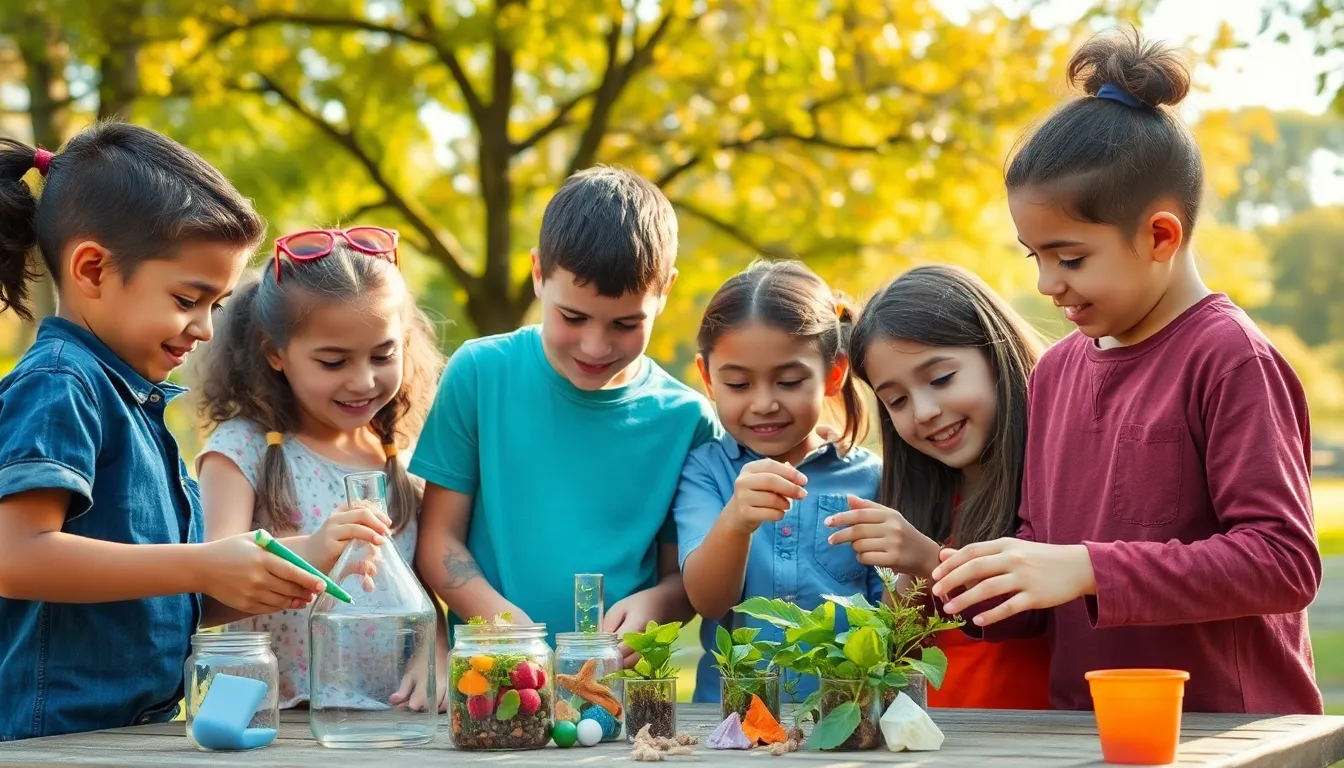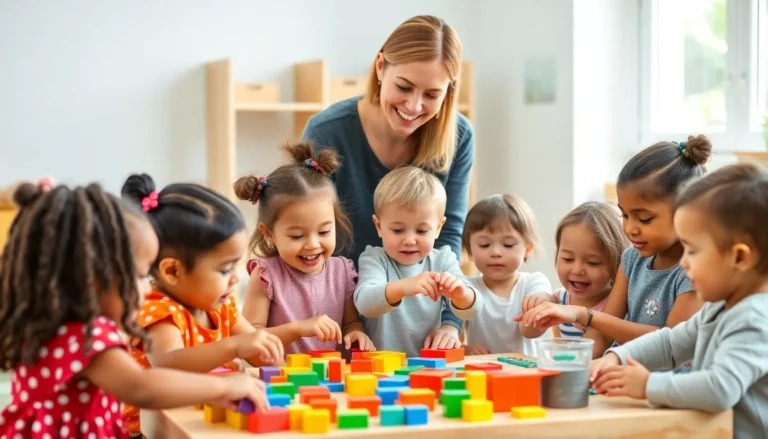Table of Contents
ToggleCuriosity is a natural spark in children, driving them to explore the world around them. This innate desire to learn shapes their understanding and fuels their imagination. Engaging this curiosity not only enhances their educational journey but also nurtures critical thinking skills that are essential in today’s fast-paced world.
Parents and educators play a pivotal role in fostering this sense of wonder. By creating stimulating environments and encouraging questions, they can guide children toward discovering new interests and developing a lifelong love for learning. In this article, we’ll explore effective strategies to ignite and sustain children’s curiosity, ensuring they remain eager explorers throughout their formative years.
Understanding Children’s Curiosity
Children’s curiosity represents a natural and essential aspect of their cognitive development. It fuels exploration, learning, and critical thinking skills necessary for success in various environments.
Definition and Importance
Curiosity in children refers to their inherent desire to seek new information and understand their surroundings. This quality plays a significant role in cognitive and emotional development. Research indicates that curious children tend to perform better academically as they engage more deeply with materials and concepts. Engaging with their curiosity stimulates problem-solving abilities and fosters a love for learning. Furthermore, curiosity promotes resilience, allowing children to navigate challenges effectively.
Stages of Curiosity Development
Curiosity evolves through various stages, influencing how children explore and learn:
- Infancy (0-1 year): Babies demonstrate curiosity through sensory exploration, bringing objects to their mouths and examining textures and sounds. They rely on caregivers for stimulation.
- Toddlerhood (1-3 years): Toddlers exhibit increased independence, exploring their environment. Asking “why” becomes common as they seek explanations for their observations.
- Early Childhood (3-5 years): Preschoolers become intensely curious, asking numerous questions. Their imagination flourishes, often engaging in pretend play, which further enhances exploratory behavior.
- Middle Childhood (6-12 years): School-aged children develop a deeper understanding of complex concepts. They pursue specific interests, engage in hands-on experiences, and participate in group discussions that foster critical thinking.
- Adolescence (12+ years): Teenagers demonstrate advanced curiosity concerning abstract concepts and personal identity. They engage in self-directed exploration, leading to deeper self-awareness and a more significant investment in learning.
Recognizing these stages helps parents and educators tailor their approaches to support and nurture children’s curiosity effectively.
Techniques for Engaging Children’s Curiosity

Engaging children’s curiosity involves specific techniques that stimulate their exploratory behavior and desire to learn. These methods not only nurture their inquisitive nature but also support cognitive development.
Open-Ended Questions
Encouraging children to think critically and express their thoughts starts with open-ended questions. These questions do not have a single correct answer, which promotes exploration. For example:
- What do you think will happen if…? This question invites predictions and imaginative thinking.
- How do you feel about…? This question encourages emotional introspection and discussion.
- Why do you think that occurs? This question stimulates reasoning and deeper understanding.
Open-ended inquiries foster dialogues, allowing children to articulate their ideas, challenge assumptions, and develop problem-solving skills.
Hands-On Activities
Hands-on activities significantly boost children’s curiosity by allowing them to engage physically with concepts. Practical experiences lead to deeper understanding and retention. Some effective activities include:
- Science experiments: Simple experiments, like growing a plant or mixing colors, provide direct learning through observation.
- Nature exploration: Encourage outdoor activities, such as scavenger hunts, to stimulate wonder about the environment.
- Craft projects: Artistic endeavors, like building models or creating art with various materials, enhance creativity and exploration.
These activities offer opportunities for children to ask questions, experiment, and discover answers through personal experience.
Role of Play in Curiosity
Play serves as a fundamental component of childhood development, significantly enhancing children’s curiosity. Through various types of play, children explore their environment, ask questions, and seek new information, all of which foster their learning and growth.
Types of Play
- Physical Play
Physical play includes activities like running, climbing, and jumping. These experiences stimulate motor skills and encourage exploration of space and surroundings.
- Pretend Play
Pretend play involves role-playing scenarios that allow children to explore different perspectives. Through imagination, they ask questions and seek answers about social interactions and relationships.
- Constructive Play
Constructive play encompasses building with blocks or assembling creative projects. This type of play promotes problem-solving and critical thinking as children experiment with structures and designs.
- Games with Rules
Games with rules, such as board games and sports, teach children about strategy and teamwork. This fosters curiosity by encouraging them to understand the objectives and develop skills to achieve them.
Benefits of Play-Based Learning
- Enhances Critical Thinking
Play-based learning encourages children to think critically as they navigate challenges during playtime. Engagement in problem-solving during these activities stimulates cognitive growth.
- Fosters Social Skills
Interactive play promotes communication and collaboration among peers. Through shared experiences, children learn to negotiate, take turns, and resolve conflicts, building essential social skills.
- Increases Motivation
Engaging in playful activities increases children’s intrinsic motivation to learn. The enjoyment derived from play encourages them to pursue knowledge and discover new interests.
- Supports Emotional Development
Play provides an outlet for emotional expression and regulation. By navigating various scenarios, children develop empathy and resilience, vital components of their emotional intelligence.
- Promotes Creativity
Play sparks creativity, as children invent new games and stories. This creative engagement nurtures their ability to think outside the box and approach problems from unique angles.
Creating a Curiosity-Friendly Environment
Creating a space that stimulates curiosity involves thoughtful design and intentional opportunities for exploration. Such environments nurture children’s natural instincts to ask questions and discover answers.
Physical Space Design
Designing a curiosity-friendly physical space includes incorporating flexible furniture arrangements and accessible materials. Incorporating open-ended play areas encourages creativity. Utilizing natural light fosters a welcoming atmosphere, while selecting colors and textures that intrigue enhances engagement. Adding diverse materials, like books, art supplies, and science kits, enables hands-on learning. Arranging spaces to include quiet corners for reading or reflective thinking invites children to explore their thoughts independently.
Encouraging Exploration
Encouraging exploration entails providing varied and stimulating experiences. Offering outdoor activities, such as nature walks or gardening, connects children with the environment. Facilitating field trips to museums, zoos, or science centers broadens their horizons. Promoting open-ended questions during playtime sparks critical thinking. Incorporating sensory activities, such as cooking or crafting, allows children to engage in diverse ways. Allowing opportunities for unstructured play fosters independence, enabling children to navigate their curiosity freely.
Engaging children’s curiosity is essential for their growth and development. By nurturing this innate desire to explore and learn, parents and educators can help children thrive academically and socially. Creating stimulating environments and encouraging open-ended questions fosters critical thinking and resilience.
Incorporating play-based learning and hands-on activities further enhances their understanding of the world. As children navigate their curiosity freely, they develop into lifelong learners equipped with the skills necessary for success in an ever-changing environment. Embracing these strategies not only enriches children’s educational experiences but also cultivates a deep love for learning that lasts a lifetime.





